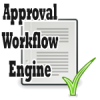For the pdf training content Click here: PeopleSoft Workflow PPT
6. Define workflow objects
When you create a business process in PeopleSoft Application Designer, you specify which activities form a business process and in what order they must be completed. The map provides an overview of the process, but it doesn’t provide a link between the activities. To link the activities to a workflow, you add routings, which automate the delivery of information to other activities and other users.
Events are conditions that have associated routings. Define the condition in PeopleCode, which is attached to the record definition underlying a step in a step map. When a user saves the page, and completing the step, the system runs the PeopleCode program to test the condition. If the condition is met, the system performs the routings.
Routings can deliver data in two forms: worklist entries and email messages. To create a routing, specify the routing type, who should receive the data, and which data you want to send. The data is usually a subset of the data from the step that triggers the routing.
Email Routings
With email routings, you can send email messages in response to business events. In some cases, you might want to define two routings for the same event: one that adds an item to someone’s worklist and one that sends an email message to tell that person about the new worklist item. You can send an email routing to anyone to whom you can send email messages through the mail system. PeopleSoft applications support email routings to any email software that supports the Simple Mail Transfer Protocol (SMTP) standards. The field Mapping and the pictures of the icons are shown in the attached ppt.
7. Define event triggers
After you create workflow processes, link them to the PeopleSoft applications by adding PeopleCode programs to the pages. The PeopleCode detects when a business rule has been triggered and determines the appropriate action.
TriggerBusinessEvent function triggers a specified business event and the workflow routings that are associated with that event. It has to written under the Workflow PeopleCode event.
If Approval Rule sets are involved then the approvers and routings are selected dynamically based on those Rule sets. Approval Rule Sets are a set of routing rules created in Application Designer.
In Approval Rule sets, the Virtual Approver determines the appropriate approver and sends a workflow routing. As each approver completes the approval, the Virtual Approver determines whether additional approvals are needed and, if necessary, sends additional workflow routings. To trigger Virtual Approver from a page, use two PeopleCode functions in the record definition that is associated with the page:
Virtual_Approver function
Use the Virtual_Approver function in the Save Edit PeopleCode. This function checks the approval rules that you defined in the approval rules sets and determines whether an item must be routed for approval. Approval rule sets are PeopleSoft Application Designer definitions that are similar in appearance to workflow maps. Approval rule sets reference business processes, but they are not embedded within business processes (unlike activities, which are part of business processes). That is, approval rule sets are not represented by physical icons on workflow maps.
Instead, approval rule sets are separate definitions that are referenced by Workflow PeopleCode. Specifically, Virtual Approver finds the next approver by calling Virtual_Approver() and then sends that person a workflow notification by calling VirtualRouter(). You use a different PeopleCode to trigger Virtual Approver than you use for other workflow events, but the function of the PeopleCode is the same: to identify the next users and to send them notifications.
Virtual_Router function
Use the Virtual_Router function in the Workflow PeopleCode. This function routes items to the next step in the approval process. Virtual_Router, a PeopleCode library function that is associated with Virtual Approver, which uses TriggerBusinessEvent internally. The Virtual_Router PeopleCode library function is located in the FieldFormula event of the APPR_VA0_WRK.FUNCLIB_02 record field.
GetApprovers PeopleCode
GetApprovers PeopleCode determines the entire list of required approvals based on the rules that are defined in an approval rule set. GetApprovers evaluates all approval steps at once so that you receive a complete list of approvers from the entire approval chain. Typically, you include GetApprovers in the Workflow PeopleCode for the transaction that requires approval.
8. Testing
Without testing no application is complete. So spend ample time testing your application to ensure the quality of your deliverable.













I have a worklist record defined as above .When I make a transaction it does not have an entry stating it has been routed but the status on the transaction page says pending for approval, can u please guide as to how i can find to whom has this transaction routed for approval?
Hi Dhiraj,
We are facing the same issue, is this issue resolved for you?
please send with exact sample example with code .
How to disable delivered self service transactions in peoplesoft workflow inquiry page?
How do I disable delivered self service transaction that appear in the prompt button of transaction name field?